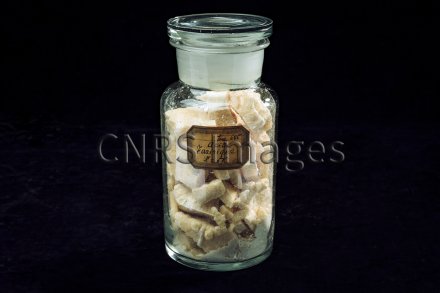Production year
2022

© Cyril FRESILLON / MCAM / CNRS Images
20220133_0017
Acide taririque conservé dans la "chimiothèque historique", collection du Muséum national d'Histoire naturelle gérée par l’unité "Molécules de communication et adaptation des micro-organismes" (MCAM). L’acide taririque est le premier acide gras acétylénique comprenant une liaison triple carbone-carbone mis au jour chez les végétaux. Léon Albert Arnaud est parvenu à l’isoler en 1892 à partir de graines de tariri, une plante originaire de Guyane nommée "Picramnia guianensis". L'unité MCAM (UMR7245 CNRS/MNHN) abrite dans sa "salle des collections" de précieux échantillons, vieux pour la majorité de plus d’un siècle, nettoyés et inventoriés en 2021 par l’équipe du laboratoire. Cet échantillon a le n° d'inventaire MNHN-CH-SC-2020-2084.
The use of media visible on the CNRS Images Platform can be granted on request. Any reproduction or representation is forbidden without prior authorization from CNRS Images (except for resources under Creative Commons license).
No modification of an image may be made without the prior consent of CNRS Images.
No use of an image for advertising purposes or distribution to a third party may be made without the prior agreement of CNRS Images.
For more information, please consult our general conditions
2022
Our work is guided by the way scientists question the world around them and we translate their research into images to help people to understand the world better and to awaken their curiosity and wonderment.